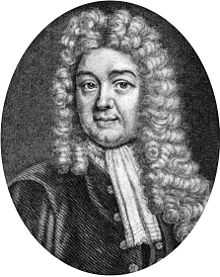Radcliffe Quadrangle


The Radcliffe Quadrangle (or Rad Quad as it is known to students of the College) is the second quadrangle of University College, Oxford, England. The buildings have been Grade I listed since 1954.[1]
The quadrangle was started in 1716 and finished in 1719 with money bequeathed to the College by John Radcliffe, a former student of the college tutored by Obadiah Walker and doctor to the King.[2] Oxford's main hospital and other University buildings are also named after him.
There is a statue of John Radcliffe by Francis Bird on the gate tower of the quad.[2] His coat of arms is also displayed.[3]
The architectural style of the quad matches that of the earlier main quadrangle immediately to the west, although this was by then rather old-fashioned for the time. It is not a "quadrangle" in the same way as the main quadrangle, because it only has buildings on three sides; the fourth side is bounded by a high stone wall separating the garden of the Master's Lodgings to the south.
To the east is Logic Lane, a small cobbled lane thorough the College, connecting the High Street at the front of the College and Merton Street at the rear. A covered bridge (built in 1903) connects the Radcliffe Quad buildings internally with other buildings on the High Street owned by the College to the east.
The Radcliffe Quad is where University College's matriculation photograph is taken at the start of each academic year.
See also
- Radcliffe Camera
- Radcliffe Infirmary
- Radcliffe Observatory
- Radcliffe Observatory Quarter
- Radcliffe Science Library
- Radcliffe Square
- John Radcliffe Hospital
References
- ↑ "University College, Radcliffe Quadrangle, Oxford". British Listed Buildings. Retrieved March 05, 2011.
- ↑ 2.0 2.1 Oxfordshire, Medical Heritage, UK.
- ↑ "John Radcliffe (1650–1714)". Lincoln College, Oxford. Retrieved March 05, 2011.
External links
- University College Access Guide
- 'Radcliffe Quadrangle, University College, Oxford' watercolour by Jane Carpini
Coordinates: 51°45′09″N 1°15′05″W / 51.75250°N 1.25139°W